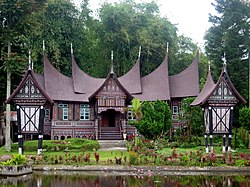
The rumah gadang (Minangkabau, "big house") is the traditional house (Indonesian: "rumah adat") of the Minangkabau. The architecture, construction, internal and external decoration, and the functions of the house reflect the culture and values of the Minangkabau. A rumah gadang serves as a residence, a hall for family meetings, and for ceremonial activities. With the Minangkabau society being matrilineal, the rumah gadang is owned by the women of the family who live there - ownership is passed from mother to daughter. One of the larger examples of the rumah gadang architectural style is the Pagaruyung Palace near Batusangkar.
Form
editA rumah gadang is a long house with multiple gables and upsweeping ridges, forming buffalo horn-like ends. Unlike the Toba Batak homes, where the roof essentially creates the living space, the Minangkabau roof rests on conventional walls. The front and side walls contain shuttered windows and display various motifs according to adat traditions, each having symbolic meaning. The motifs are similar to those of the Minangkabau songket. The roof is a truss and cross-beam construction, and is typically covered with thatch from the fibre of the sugar palm (ijuk), or more frequently in modern times, corrugated iron.
The rumah gadang is built in one of two basic designs: Koto Piliang and Bodi Caniago. These forms reflect different two variations of Minangkabau social structure. The Koto Piliang design reflects an aristoctatic and hierachical social structure, with the house containing anjuang (raised floors) at each end to permit elevated seating of clan leaders during ceremonial events. The Bodi Caniago design reflects a democratic social structure, with the floors being flat and on one level.
Architectural elements
editEach element of a rumah gadang has its own symbolic meaning, which is referred to in adat speech and aphorisms. The elements of a rumah gadang includes:
- gonjong, hornlike roof structure
- singkok, triangular wall under the ends of gonjong
- pereng, shelf under the singkok
- anjuang, raised floor at the end of one style of rumah gadang
- dindiang ari, the walls on the side elevations
- dindiang tapi, the walls on the front and back elevations
- papan banyak, front facade
- papan sakapiang, a shelf or middle band on the periphery of the house
- salangko, wall enclosing space under a house that has been built on stilts
Construction
editThe construction of a house is subject to specific regulations, laid down by the ancestors and formalised in adat, that need to be observed if the house is to become a beautiful and pleasant building. The construction and maintenance of a rumah gadang is the responsibility of ninik mamak, the elder male blood-relatives of the matrilineal descent group that owns and builds it.
See also
editReferences
edit- Dawson, B. (1994). The Traditional Architecture of Indonesia. Thames and Hudson Ltd. ISBN 0-500-34132-X.
{{cite book}}: Unknown parameter|coauthors=ignored (|author=suggested) (help) - Summerfield, Anne (1999). Walk in Splendor: Ceremonial Dress and the Minangkabau. UCLA. ISBN 0-930741-73-0.
{{cite book}}: Unknown parameter|coauthors=ignored (|author=suggested) (help) - Vellinga, Marcel (March 2004). "A family affair: the construction of vernacular Minangkabau houses". Indonesia and the Malay World. 32 (92). Routledge: 100–118. doi:10.1080/1363981042000263480.
- Kartikawening, Dyah (2002). "Public Space Dynamic in Minangkabau Rural Area Indonesia" (PDF). 2002 American Planning Association National Planning Conference Proceedings.
- Ng, Cecilia (1993). "Raising the House Post and Feeding the Husband Givers: The Spatial Categories of Social Reproduction Among the Minangkabau.". Inside Austronesian Houses: Perspectives on Domestic Designs for Living. pp. 121–143. ISBN 1-920942-84-X.
{{cite conference}}: Cite has empty unknown parameter:|coauthors=(help) - Nas, Peter J.M. (1999). "Small town symbolism: The meaning of the built environment in Bukittinggi and Payakumbuh". Urban Symbolism and Rituals. Ljubljana: 173–189.
{{cite journal}}: Unknown parameter|coauthors=ignored (|author=suggested) (help)